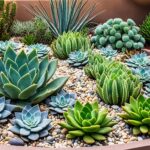“water-wise gardening”
Create a Beautiful Succulent Garden: Simple Steps
Creating a beautiful garden doesn’t have to be hard or expensive. With succulents, you can have a garden that’s easy to maintain and looks great. These plants store water, so they need little care. They’re perfect for anyone who wants a beautiful garden without the hassle.
Planting succulents is simple. They’re tough and can survive with little water. You only need to water them once every week or two. So, get your trowel, gloves, and sunscreen ready. It’s time to start your own succulent garden.
Key Takeaways
- Succulents are low-maintenance, drought-tolerant plants that can thrive with minimal care.
- Creating a succulent garden is an easy and effortless way to enhance your outdoor space.
- Proper soil, watering, and light requirements are essential for the health and growth of succulents.
- Succulents come in a wide variety of shapes, sizes, and colors, allowing for a diverse and visually appealing garden.
- Succulents are a great choice for beginner gardeners or those looking for a low-maintenance landscaping option.
Introduction
Succulents are fascinating plants that have become very popular lately. They come in many shapes, sizes, and colors. This makes them perfect for those wanting to learn about succulent care or how to care for cacti. They are great for both experienced and new gardeners. Adding drought-tolerant plants to your outdoor gardening, low-maintenance landscaping, or container gardening can be fun and rewarding.
This guide will explore the world of succulents. We’ll look at their unique traits, best growing conditions, and how to keep them thriving. By the end, you’ll know a lot about these plants and how to make a beautiful, easy-care garden.
Succulents store water in their leaves, stems, and roots. This makes them tough and able to live in many climates. They come in many shapes, from simple rosettes to complex designs. Many also have beautiful flowers that add to their appeal.
“Succulents are the perfect plants for those who have a passion for gardening but don’t have much time to devote to it. They thrive on neglect and require minimal care, making them an ideal choice for busy individuals or those new to the world of plant parenting.”
Succulents are great for creating a low-maintenance landscaping or a striking container gardening setup. They can grow well in many conditions. These drought-tolerant plants add beauty to any space, indoors or outdoors. They’re a favorite among those who enjoy succulent care and how to care for cacti.
Choosing the Right Plants
Choosing the right plants is key to a beautiful and thriving succulent garden. Succulents vary in shape, size, and color, each with unique care needs. It’s vital to know what each plant requires before you start.
Think about how much sun your garden gets when picking succulents. Some, like snake plants and jade plants, do well in shade. Others, such as aloe, aeoniums, and agave, love full sun. Knowing your garden’s sun levels helps pick the right drought-tolerant plants for your space.
Also, consider the soil needs of succulents. They like soil that drains well to prevent root rot. Heavy soils can harm them. Use a cactus or succulent potting mix, or mix sand, perlite, and compost yourself.
| Succulent Type | Sun Exposure | Soil Preference |
|---|---|---|
| Snake Plant | Partial Shade to Full Sun | Well-draining |
| Jade Plant | Partial Shade to Full Sun | Well-draining |
| Aloe Vera | Full Sun | Well-draining |
| Aeonium | Full Sun | Well-draining |
| Agave | Full Sun | Well-draining |
By picking the right plants for your succulent garden, you’re on your way to a thriving garden. With proper care, your succulents will flourish for years.
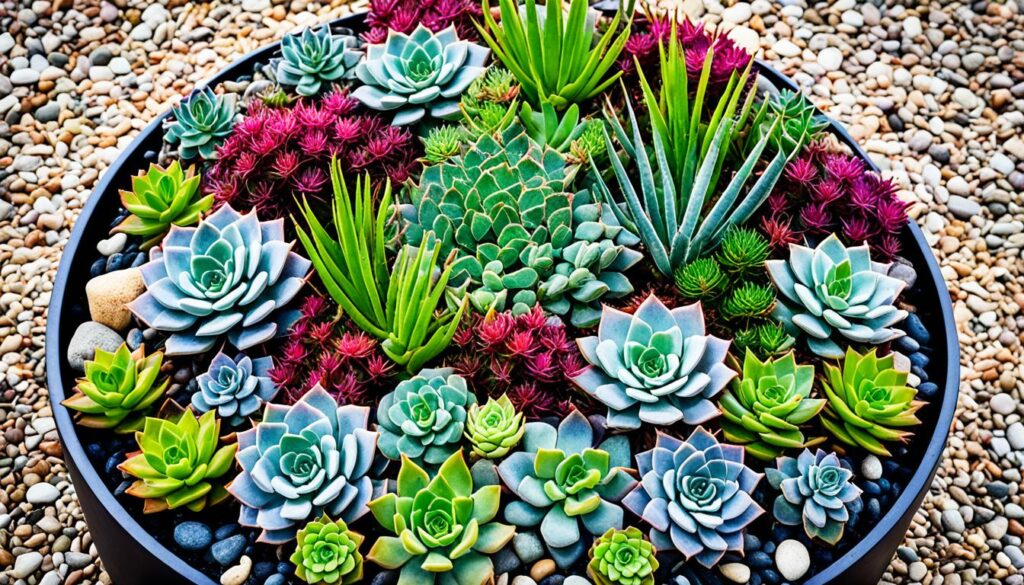
Potting and Soil
Creating a thriving succulent garden starts with the right potting soil. Succulents need soil that drains well to prevent root rot. This is because they can’t handle too much moisture.
For your succulents to do well, mix organic matter like compost with materials that help with drainage. Think about adding sand, grit, pumice, perlite, small gravel, or crushed granite. This mix gives them the nutrients they need and ensures good drainage.
Transplanting succulents can be tricky, but they’re tough plants. Even if roots get damaged or the plant moves around, they usually recover fast. With the right soil for succulents and some care, you can make a beautiful succulent garden indoors or outside.
“The key to success with succulents is understanding their soil needs. By creating a well-draining mix, you’ll set them up for long-term succulent care and vibrant growth.”
When potting your succulents, use containers with drainage holes. This stops water from building up and harming the plants. Whether you’re gardening outdoors or in containers, the right soil and potting methods are key to a beautiful, easy-to-care-for succulent garden.
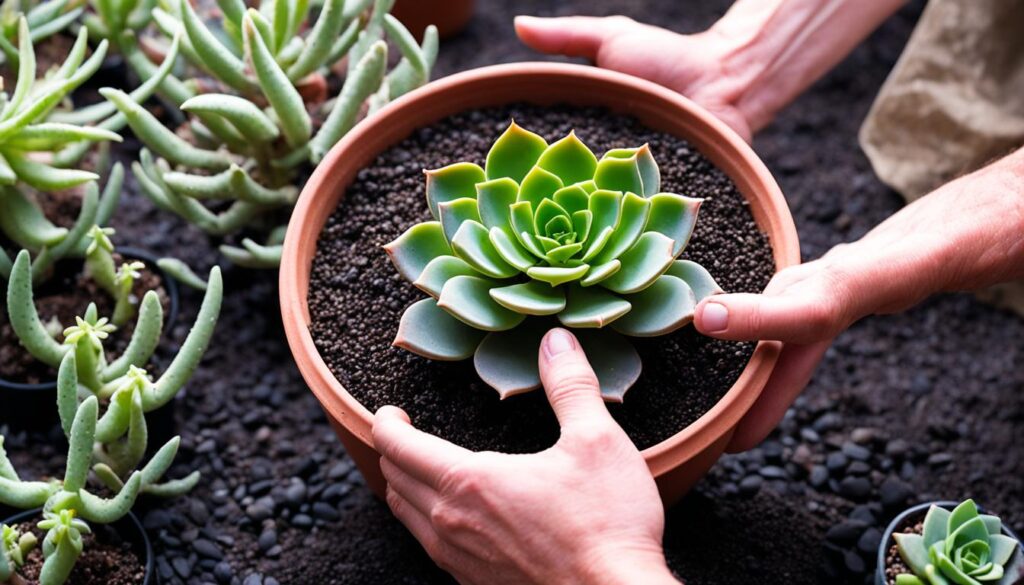
Watering Guidelines
Watering your succulent garden right is key. Too much water can hurt them just like too little. Succulent and cactus plants don’t like wet soil because it can cause root rot. So, water them deeply but not too often.
Start by waiting a day or two after planting before you water your outdoor gardening or container gardening succulents. This lets their roots heal and get used to their new spot. Then, check the soil by sticking your finger into the top layer. If it’s dry, it’s time to water. If it’s still damp, wait a bit longer.
- Water your succulents deeply, letting the soil soak up the moisture.
- Wait until the soil is dry before watering again, usually every week or two.
- Don’t keep the soil wet all the time, as this can cause watering succulents problems like root rot.
It’s safer to underwater your succulent care plants than to overwater them. Dry soil is easier for them to bounce back from than root rot. By following these watering guidelines, you’ll help your succulent garden thrive.
“Watering succulents is an art, not a science. Err on the side of too little water rather than too much.”
Light and Temperature Requirements
Light and temperature are key for a healthy succulent and cactus garden. Whether you’re growing drought-tolerant plants inside or outside, knowing what they need is vital. This knowledge helps with their care and upkeep.
Succulents need a lot of sunlight, but some like a little shade. For example, snake plants and jade plants do well in the shade. On the other hand, aloe, aeoniums, and agave love the sun.
Succulents can handle different temperatures. The soft ones prefer warm weather above 50 degrees Fahrenheit. They can’t stand the cold. But, some like hens and chicks, stonecrop, and hardy yellow ice plant can get as cold as -20 degrees Fahrenheit.
Knowing what your succulents need for light and temperature lets you create the best conditions. This is true whether you’re tending to a container garden or an outdoor one. It ensures these plants thrive with little effort.
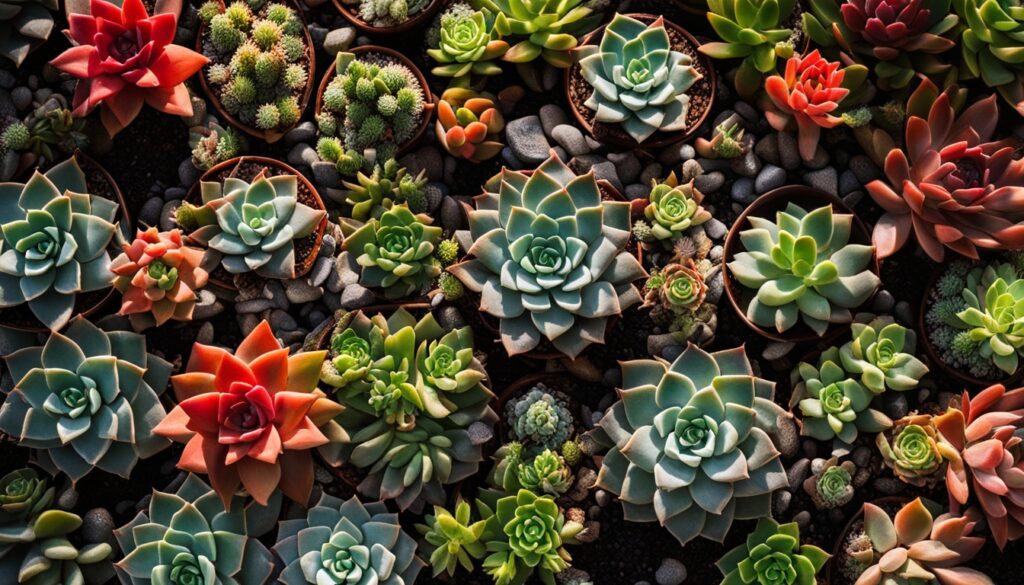
| Succulent Type | Lighting Needs | Temperature Tolerance |
|---|---|---|
| Snake Plant | Partial Shade | 50°F – 90°F |
| Jade Plant | Partial Shade | 50°F – 80°F |
| Aloe Vera | Full Sun | 55°F – 85°F |
| Aeonium | Full Sun | 50°F – 75°F |
| Agave | Full Sun | 40°F – 110°F |
| Hens and Chicks | Full Sun | 40°F – -20°F |
| Stonecrop | Full Sun | 40°F – -20°F |
| Hardy Yellow Ice Plant | Full Sun | 40°F – -20°F |
Feeding and Fertilizing
Caring for your succulent plants means paying attention to their diet and nutrients. Succulents are easy to care for and don’t need a lot of food or fertilizer. In fact, giving them too much can harm them, causing them to grow too long and making them more likely to get pests and diseases.
It’s best to feed your succulents a balanced, water-soluble fertilizer that’s only half-strength. You can give it to them every few months when they’re growing. Or, you might prefer a slow-release organic fertilizer. This type of fertilizer feeds your plants over time without the risk of giving them too much.
Remember, succulents like it when you don’t overdo it. Don’t try to feed them too much, as this can mess with their natural growth. It might even lead to bad results for your outdoor or container garden.
Fertilizing Tips for Healthy Succulents
- Use a balanced, water-soluble fertilizer diluted to half-strength
- Apply the fertilizer every few months during the growing season
- Alternatively, opt for a slow-release organic fertilizer
- Avoid over-fertilizing, as this can lead to leggy growth and make the plants more susceptible to pests and diseases
- Consider the specific needs of your low-maintenance landscaping succulents when choosing a fertilizer
| Fertilizer Type | Frequency | Benefits | Drawbacks |
|---|---|---|---|
| Water-soluble Fertilizer (Half-strength) | Every 2-3 months during growing season | Provides a gentle, controlled nutrient boost | Potential for over-fertilization if not diluted properly |
| Slow-release Organic Fertilizer | Once a year | Gradual nutrient release, less risk of over-fertilization | May not provide immediate nutrient availability |
By following these simple guidelines, you can make sure your succulent garden does well without needing a lot of fertilizer. Remember, it’s all about balance when feeding and fertilizing your drought-tolerant plants. This way, you’ll have a beautiful, easy-to-care-for landscape.
“The key to successful succulent gardening is understanding their unique nutritional needs and providing just the right amount of fertilizer to keep them healthy and happy.”
Repotting and Propagation
Keeping your succulent garden healthy means repotting and propagating them now and then. Succulents, being tough plants, only need a new pot every 2-3 years or when they get too big. When it’s time, carefully take the plant out, cut off any dead roots, and put it in a bigger pot with fresh soil.
Propagating succulents is fun and helps grow your garden and share plants with others. Many types of succulents can be grown from cut leaves or stems. Let the cut dry, then plant it in good soil and keep it moist until it grows new roots. Propagating succulents is rewarding and can give you beautiful new plants.
Repotting Succulents
- Gently remove the succulent from its current container, being careful not to damage the roots.
- Inspect the roots and trim any damaged or dead portions using clean, sharp scissors.
- Select a new pot that is only slightly larger than the previous one, ensuring it has adequate drainage holes.
- Fill the new pot with fresh, well-draining succulent soil, leaving enough space for the plant’s root system.
- Replant the succulent, making sure it is positioned at the same depth as it was in the previous pot.
- Water the plant thoroughly, then allow the soil to dry slightly before watering again.
Propagating Succulents
- Choose a healthy, mature leaf or stem from the succulent you wish to propagate.
- Allow the cutting to dry and form a callus over the exposed end, which typically takes 1-2 days.
- Plant the cutting in a well-draining succulent soil mix, burying the calloused end about an inch deep.
- Keep the soil lightly moist, but avoid overwatering, until new growth appears.
- Once the cutting has established roots and new growth, you can transplant it into a larger container.
- Some of the easiest succulents to propagate include Sedum, Aeonium, Echeveria, and Graptoveria.
| Succulent Variety | Propagation Method | Rooting Time |
|---|---|---|
| Jade Plant (Crassula) | Stem or Leaf Cutting | 2-3 weeks |
| Echeveria | Leaf Cutting | 2-4 weeks |
| Graptopetalum | Stem or Leaf Cutting | 3-4 weeks |
| Kalanchoe | Stem or Leaf Cutting | 2-3 weeks |
By repotting and propagating your succulents, you can keep a beautiful, succulent garden that looks great all year and is easy to care for.
“Succulents are the perfect plants for busy gardeners who want to create a low-maintenance, drought-tolerant oasis.”
Dealing with Common Issues
Succulents are usually easy to care for but can face some common problems. One issue is mealybug infestations, which can be fixed with a diluted isopropyl alcohol solution. Overwatering is another problem, causing root rot and yellow leaves. To fix this, let the soil dry out and use containers with good drainage holes.
Succulents can also get sunburned, especially when they’re new. Look for white, brown, black, or beige spots on the leaves. These spots mean the plant needs more shade. With proper care, these plants can recover and do well in your garden or containers.
FAQ
What are succulents and why are they a good choice for a garden?
Succulents are plants that store water in their leaves and stems. They come in many shapes, sizes, and colors. They have beautiful patterns like spirals and rosettes. These plants are great for gardens because they need little care and can survive with less water.
How do I choose the right spot for my succulent garden?
Think about how much sunlight the area gets when picking a spot for your succulents. Some like shade, others need full sun. Make sure the soil drains well to prevent root rot.
What type of soil do succulents need?
Succulents like soil that drains well, which is sandy. You can make good soil by mixing in compost and materials like sand, grit, pumice, perlite, small gravel, or crushed granite.
How often should I water my succulent garden?
Water your succulents when the soil is dry, usually every week or two. It’s safer to water less than too much, as succulents can get root rot from too much moisture.
What are the light and temperature requirements for succulents?
Most succulents need a lot of sunlight, but some can handle shade. Soft succulents do well in warm places above 50 degrees Fahrenheit. Frost-hardy ones can handle colder temperatures between 40 and -20 degrees Fahrenheit.
Do succulents need to be fertilized?
Succulents don’t need much care and rarely need fertilizer. You can use a weak, balanced fertilizer a few times a year during the growing season. Slow-release organic fertilizers work well too. But, don’t overdo it, as it can cause weak growth and make them more prone to pests and diseases.
How do I repot and propagate succulents?
Repot your succulents every 2-3 years or when they’re too big for their pot. When you repot, carefully remove the plant, trim dead roots, and put it in a bigger pot with fresh soil. You can also grow new succulents from cuttings.
What are some common issues with succulents and how do I address them?
Succulents might get mealybugs, be overwatered, or get sunburned. Use a weak isopropyl alcohol solution to fight mealybugs. Let the soil dry out and improve drainage to fix overwatering. Move the plant to a shadier spot to prevent sunburn.
Earth-Friendly Gardening: Techniques for a Greener Outdoor Space
Are you ready to make your garden green in a big way? Earth-friendly gardening is more than a trend. It’s a smart way to care for your space and the world. By choosing to garden this way, you do less work, save cash, and help the planet. Your garden gets healthier, too.
Key Takeaways:
- Earth-friendly gardening is a practical and sustainable approach to landscaping.
- Sustainable gardening practices can reduce your workload and save money.
- By adopting earth-friendly gardening techniques, you can minimize your environmental footprint.
- Sustainable gardening improves the overall health of your garden.
Are you ready to revolutionize your garden with sustainable practices that benefit both your plants and the planet?
Welcome to the world of earth-friendly gardening! In this section, we’re going to talk about sustainable gardening. We’ll show you how it helps both the environment and your plants.
Earth-friendly gardening focuses on sustainability. It aims to create a balance where nature and people can flourish together. By using sustainable practices, we can use less resources, cut down on waste, and protect many kinds of life. This makes your outdoor space greener and helps the planet.
Why should you try sustainable gardening? We’ll look at its benefits now.
1. Environmental Impact: Sustainable gardening cuts down on chemicals and synthetic fertilizers. This reduces pollution and helps wildlife.
2. Soil Health: Practices like composting and mulching make soil fertile. Healthy soil is key for a great garden!
3. Water Conservation: Techniques like rainwater harvesting save a lot of water. This is good for the planet and your water bill.
4. Cost Savings: Using organic methods can help you spend less on fertilizers, pesticides, and water.
5. Beauty and Harmony: Sustainable gardens are beautiful. They create an outdoor space that looks good and is eco-friendly.
6. Connection with Nature: Sustainable gardening helps you connect with nature. It lets you appreciate the natural world more.
Excited to make your garden more eco-friendly? Next, we’ll cover sustainable gardening’s principles and techniques. We’ll discuss water conservation, organic gardening, biodiversity, and more. Get ready to make your outdoor space greener!
The Foundation of Earth-Friendly Gardening
What is a Sustainable Garden?
Understanding earth-friendly gardening starts with knowing what a sustainable garden is. It uses environmental stewardship principles. Its goals include using fewer non-renewable resources and lessening ecosystem harm. Instead of synthetic fertilizers and lots of water, it uses organic methods, supports many living things, and saves water.
A sustainable garden cares for the environment and keeps going with little outside help. It looks after plant, soil, and wildlife health, making a balanced ecosystem. By working with nature, it not only does well itself but also helps the bigger ecosystem.
Building a sustainable garden means adding several things and methods. These involve:
- Native plants: Picking local plants helps area wildlife and cuts down on water and chemical use.
- Composting: Kitchen leftovers and garden trimmings make compost, feeding the soil and cutting down synthetic fertilizer use.
- Water-wise irrigation: Using smart watering, like drip irrigation or collecting rain, saves water and reduces waste.
- Natural pest control: Attracting helpful insects and birds handles pests without chemicals.
- Soil health: Keeping soil healthy with mulching, rotating crops, and covering the soil supports plant life and strength.
Check out this table to see the important parts of a sustainable garden:
| Elements of a Sustainable Garden | Description |
|---|---|
| Native plants | Choosing plants fit for the local weather and soil saves water and supports different life forms. |
| Composting | Turning waste into compost enriches the soil and reduces the need for artificial fertilizers. |
| Water-wise irrigation | Smart watering methods like drip systems and collecting rain cuts down on water use. |
| Natural pest control | Inviting insects and birds that eat pests naturally reduces chemical pesticide use. |
| Soil health | Improving the soil with mulching, planting different crops in turn, and ground cover helps plants grow better. |
With a sustainable garden, you can have a lively outdoor area that’s good for the environment. Next, we’ll explore more about how to make and care for an earth-friendly garden.
Water Conservation Techniques
Water conservation is key for earth-friendly gardening. You can cut down on water use and still have a great garden. Let’s look at ways to use less water and save this vital resource.
Gathering rainwater is a smart move. You can collect and store rainwater by setting up a rain barrel or a system. This helps you use less tap water and stops runoff and erosion.
Using smart irrigation is crucial for saving water in gardens. Systems like drip irrigation give water right to plant roots, which cuts down waste. Setting a timer for early morning or late evening can also help reduce evaporation.
Mulching is another great water-saving tip. It keeps the soil moist by stopping water from evaporating. Put a layer of organic mulch around your plants to help keep water in the soil.
Choosing the right plants can also save water. Go for plants that need less water and are right for your area. Also, plant things with the same water needs close to each other. This makes watering more efficient.
Keep an eye on your garden’s water use, too. Check for leaks in your watering systems and fix them fast. Catching leaks early helps stop water from being wasted.
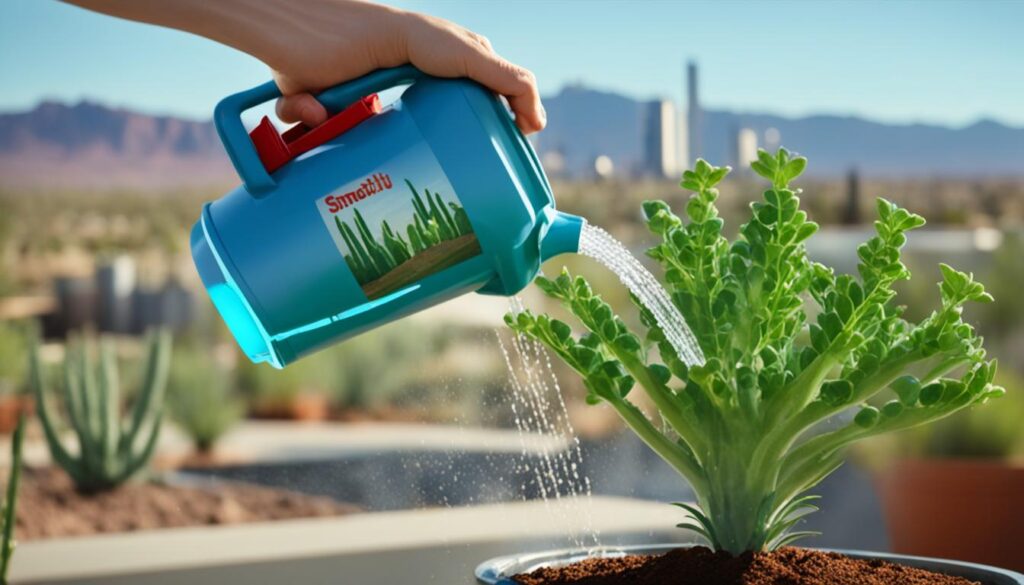
Using these tips, you can cut back on water in your garden. This makes your outdoor space more sustainable and good for the planet.
| Technique | Benefits |
|---|---|
| Collecting rainwater | – Reduces reliance on municipal water supplies – Prevents stormwater runoff and erosion |
| Efficient irrigation methods | – Minimizes evaporation and waste – Optimize watering times |
| Mulching | – Reduces evaporation and maintains soil moisture – Improves soil health |
| Proper plant selection | – Reduces water requirements – Supports local ecosystems |
| Regular maintenance | – Prevents water waste from leaks – Ensures efficient water usage |
Organic Gardening Methods
Organic gardening helps our planet. It lets you grow a beautiful garden without bad chemicals. We’ll see why organic gardening is good and how to do it.
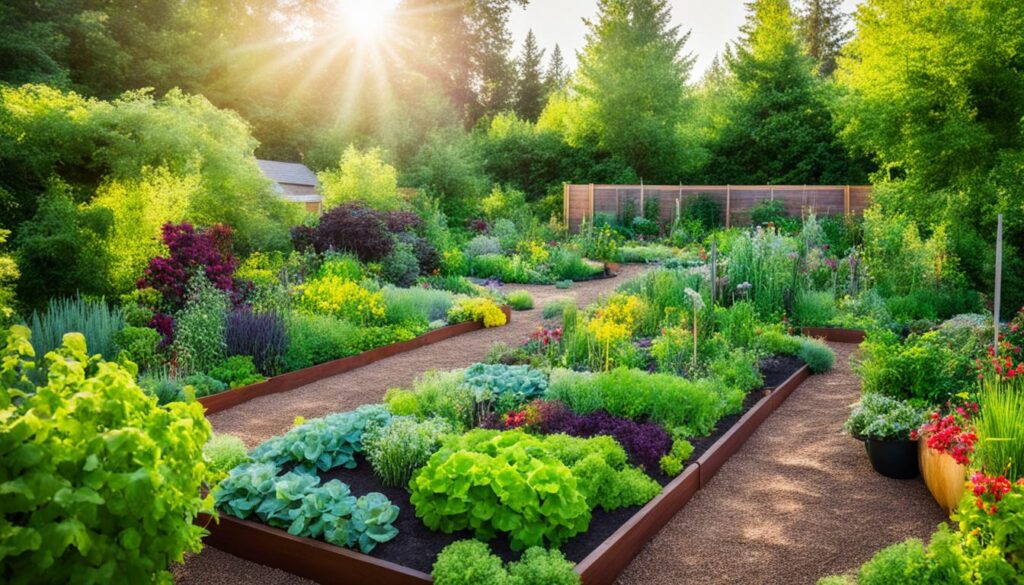
“Organic gardening is more than just growing plants without synthetic chemicals. It’s about nurturing and supporting the natural processes that sustain life.”
Organic gardening has great benefits:
- 1. Environmental Safety: It makes a healthy place by avoiding harmful chemicals. This helps wildlife and keeps water clean.
- 2. Healthier Produce: Foods grown organically are safe and full of nutrients. They’re better for you and your family.
- 3. Soil Health: This kind of gardening makes the soil strong and fertile. Healthy soil means a better garden.
- 4. Biodiversity: Organic gardens welcome bees, friendly bugs, and animals. They don’t use chemical bug killers.
Now, here’s how to garden organically:
- Choose Organic Seeds or Starts: Pick seeds or starts that are organic. This makes sure your plants are safe and natural.
- Improve Soil Quality: Add things like compost or old manure to your soil. This makes it better for your plants.
- Natural Fertilizers: Feed your plants with organic stuff like compost tea. This keeps the soil healthy for a long time.
- Companion Planting: Grow plants like marigolds or basil together. This keeps pests away and brings in good bugs.
- Biocontrols: Use bugs like ladybugs to fight pests. They help without needing chemicals.
- Mulch: Use organic mulch around plants. It stops weeds and keeps soil moist.
Using these tips, your garden can be safe and full of life. Enjoy gardening with nature’s help!
Encouraging Biodiversity
Biodiversity is key for a healthy and strong garden. By bringing more biodiversity to your garden, you make it prettier. You also help the planet stay healthy.

- Plant native species: Native plants fit well with the local weather. They give food and homes to local animals.
- Create wildlife habitats: Add things like birdhouses, bat boxes, and bee hotels. They draw lots of different animals.
- Provide water sources: Put in a bird bath, pond, or small water spot. It will attract birds, bugs, and others.
- Attract beneficial insects: Grow flowers that pull in pollinators like bees and butterflies. This also brings in bugs that eat pests.
- Plant a diverse range of species: Use plants of many sizes, shapes, and bloom times. This draws a big mix of wildlife to your garden.
By welcoming more biodiversity, you make your garden thrive. It will support many kinds of plants and animals.
Reducing Your Garden’s Carbon Footprint
Making your garden more sustainable is key. We’ll talk about how gardens add to carbon emissions. We’ll also give tips to reduce your garden’s impact. Using sustainable designs and eco-friendly materials helps.
Eco-Friendly Garden Maintenance
Maintaining an eco-friendly garden means using sustainable ways all year. By following these tips for eco-friendly garden care, you keep your garden green:
- Proper pruning techniques: Pruning is key in keeping a garden healthy. By pruning selectively, you remove only the bad parts. This helps with airflow and lowers pest risks. Always use clean, sharp tools and sterilize them after each cut to stop disease spread.
- Responsible use of garden tools and equipment: Whenever you can, use hand tools like pruners and weeders. They use less energy. If you need power tools, go for those that are electric or battery-run. They are quieter and pollute less than gas ones.
- Effective waste management: Don’t throw away organic waste such as leaves. Compost them to reduce landfill waste and make good soil. Also, consider leaving grass clippings on your lawn. They break down and feed the grass naturally.
Small changes in how you care for your garden can help the planet. Using these green techniques makes your garden and the earth healthier.
Comparison of Garden Tools
| Tool Type | Advantages | Disadvantages |
|---|---|---|
| Manual Tools | Low energy consumption Quiet operation No air pollution |
Requires physical effort Not suitable for large areas |
| Electric Tools | Lower noise levels compared to gas-powered tools No direct emissions |
Dependency on electricity Limited mobility due to cord length or battery life |
| Gas-Powered Tools | Greater power for heavy-duty tasks Longer running time |
Noise pollution Direct emissions of pollutants More maintenance |
Inspiring Examples of Earth-Friendly Gardens
Want to make your garden eco-friendly? Look at these sustainable gardens. They show how to be green in any space. From tiny city lots to big suburban areas.
The Field of Dreams is in the city. It proves small places can become green havens. It uses vertical plants, pots, and collects rainwater. This makes it productive but eco-friendly.
The Green Haven is great for those with more land. It has native plants, rain gardens, and special paving. These choices help wildlife, save water, and stop flooding. Recycled paths and solar lights add to its green touch.
Meadowsong Sanctuary is out in the countryside. It follows permaculture and regenerative farming. This means it supports itself. It uses natural ways to keep pests away and plants that help each other. It also welcomes animals.
For more eco-gardening tips, visit the Royal Horticultural Society. They have a guide full of ideas. It helps make gardens both pretty and green.
Conclusion
Earth-friendly gardening is more than just a trend. It’s a smart way to design your outdoor space. It helps the planet and makes your garden better. You will work less, save money, and help nature.
This guide showed you how to garden in a planet-friendly way. We talked about saving water and avoiding chemicals. Encouraging various plants and animals is also key.
Now, it’s your turn to try these green gardening methods. By doing this, you help our planet and get a lovely garden. So, put on your gardening gloves. Let’s take a step towards eco-friendly gardening together!
FAQ
What is earth-friendly gardening?
It’s gardening in a way that helps the planet. This means using less water and avoiding harmful chemicals. It also means growing plants that help the environment.
Why is earth-friendly gardening important?
This type of gardening has many benefits. It saves water and helps the soil. It also makes your garden a healthier place. Plus, it’s good for the earth.
How can I conserve water in my garden?
To save water, collect rainwater and choose smart watering systems. Use mulch to keep soil moist. Also, grow plants that don’t need much water.
What are organic gardening methods?
Organic gardening means using natural stuff to help your garden grow. This includes things like compost and avoiding man-made chemicals. It keeps your garden and the earth healthier.
How can I encourage biodiversity in my garden?
For more biodiversity, grow local plants and make homes for wildlife. Also, attract helpful bugs and animals. This makes your garden full of life and good for nature.
How can I reduce my garden’s carbon footprint?
Use eco-friendly designs and materials in your garden. Compost your waste and cut down on gas tools. These steps help your garden pollute less.
What are some eco-friendly garden maintenance practices?
Keep your garden green by pruning correctly and using efficient tools. Also, handle waste the smart way. These practices keep your garden healthy and green all year.
Can you provide examples of earth-friendly gardens?
Yes! There are many great examples out there. They show how to garden in ways that are good for the earth. You can find ideas for your own garden by looking at these examples.
Source Links
- 10 Must-Have Blooms for Your 2025 Garden
- The Health Advantages of Gardening You Need to Know
- How to Create a Small Vegetable Garden Layout Plan: A Beginner’s Guide
- DIY Garden Projects for Small Spaces: Upcycling Ideas to Maximize Your Garden
- Watering Techniques for Small Gardens: Ensuring Your Plants Thrive
- Small Border Plants for Landscaping: Adding Beauty and Functionality to Your Garden
- Year-Round Small Space Gardening: Seasonal Planting Tips for Maximum Harvest
- Essential Tools for Small-Space Gardening: What You Really Need
- The Ultimate Guide to Container Vegetables: What to Grow in Small Spaces
- Budget-Friendly Gardening: How to Create a Thriving Garden on a Tight Budget
- How to Optimize Sunlight in Small Gardens: Tips for Better Plant Growth
- DIY Vertical Planters: Creative Ideas for Small Space Gardening
- Companion Planting for Small Vegetable Gardens: Boost Growth and Deter Pests
- Container Gardening Essentials: Choosing the Right Pots, Soil, and Plants
- Vertical Gardening Techniques: Maximizing Your Small Space with Climbers and Vines
- How to Build a Raised Bed Garden in a Small Backyard: Step-by-Step Guide
- The Best Vegetables for Small-Space Gardens: High-Yield Varieties You Need to Grow
- Smart Vegetable Garden Layouts for Small Spaces: Maximizing Your Green Thumb in Compact Areas
- 40. Best Practices for Managing a Sustainable Garden Year-Round
- Building a Wildlife Pond for Biodiversity
- Advanced Techniques in Sustainable Gardening
- How to Create a No-Till Garden
- The Mental Health Benefits of Gardening
- Using Technology to Enhance Sustainable Gardening
- Getting Certified Organic: Steps and Benefits
